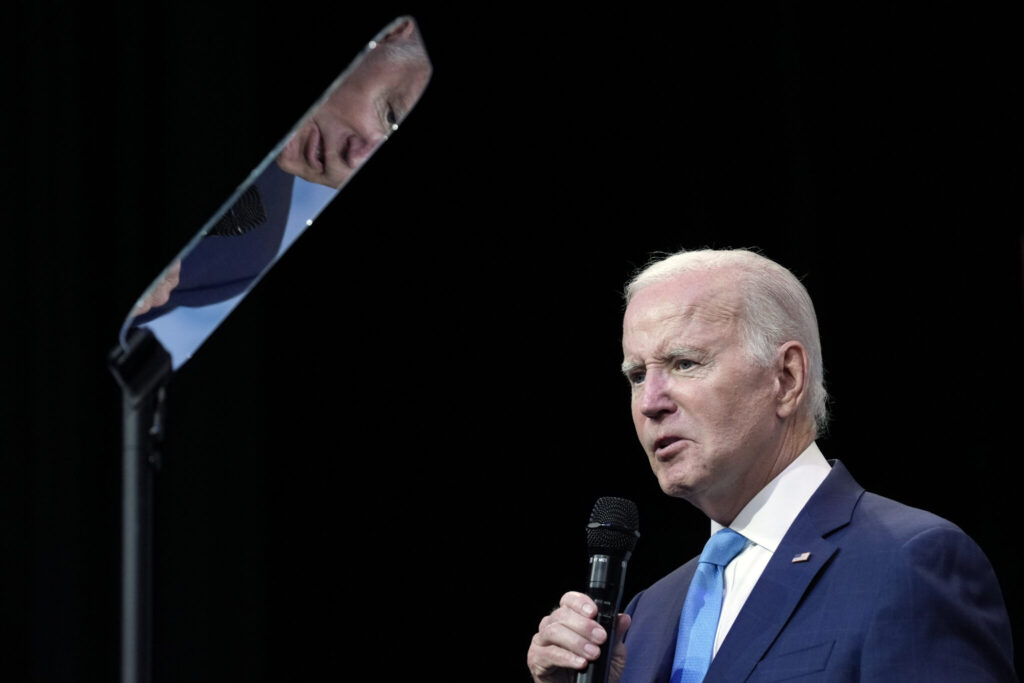President Joe Biden has his zingers (“This is not your father’s Republican Party”). He’s got patriotism (“This is the United States of America, dammit”). He’s got a geometry-based explanation on how to grow the economy (“from the middle out and the bottom up”). If you’ve heard one of the president’s recent speeches, you’ve basically heard them all — and you’re sure to keep hearing the same refrains in the year-plus leading up to Election Day 2024. People in Arizona, New Mexico and Utah will get to sample the playlist starting Tuesday, when Biden makes a three-day swing through the Southwest. The Associated Press has the story:
Joe Biden bets that repeating his slogans is smart politics
Newslooks- WASHINGTON (AP)
President Joe Biden has his zingers (“This is not your father’s Republican Party”). He’s got patriotism (“This is the United States of America, dammit”). He’s got a geometry-based explanation on how to grow the economy (“from the middle out and the bottom up”).
Move over, Beyonce and Taylor Swift. Biden has his own greatest hits and he’s keeping them on repeat.
If you’ve heard one of the president’s recent speeches, you’ve basically heard them all — and you’re sure to keep hearing the same refrains in the year-plus leading up to Election Day 2024. People in Arizona, New Mexico and Utah will get to sample the playlist starting Tuesday, when Biden makes a three-day swing through the Southwest.

Biden knows where the country is in the arc of history (“at an inflection point”). He knows what the middle class needs (“a little bit of breathing room”). Did you know his wife, Jill, is from Philadelphia? Yep, he “married a Philly girl” and will be “sleeping alone” if he fails to root for Philadelphia sports teams.
The repetition is a strategic choice — one with a scientific basis in a society that is loaded with distractions. People need to see his TV ads and speeches dozens of times before they truly absorb them, his campaign believes. The president has built a multi-decade political career on repeating the same stories in order to explain the principles behind his policies.
“That’s communications 101 — developing a compelling message and repeating it again and again,” said White House communications director Ben LaBolt, who noted that marketing has a “rule of seven” in which a customer generally needs to see a message at least seven times before making a purchase.
LaBolt noted that most voters are busy taking their kids to soccer, making breakfast or commuting to their jobs. ”They’re not consuming news like they’re sitting in the White House briefing room — you have to repeat a message over time so that people remember it,” he said, noting that this has become increasingly the case in a fractured media environment.

The president has staked his reelection on convincing a wary public that the economy is rock solid because of his policies.
That means Biden is putting his economic pitch on repeat, hoping to break through the daily clutter by delivering his message often enough that voters will recall it and accept it as truth. The White House thinking is that voters will turn out for him if they know that their new bridge, new factory or tax break for an electric vehicle came from his legislative accomplishments.
He’s even repeated in speeches the importance of repetition.
“We got to let people know what we’ve done and how we’ve done it and why we did it,” he recently told donors in Chicago after delivering a speech about “Bidenomics” — a term he has used at least 39 times during the past month in public remarks.
Philly girl Jill Biden has her own estimates for how often her husband deploys one of his other favorite phrases about the economy.

“It’s the future of our workforce, how we strengthen the economy from the bottom up and the middle out,” she said at a recent childcare event. “Joe has said that, I think, a million times.”
Close readers of the president’s speeches will note that sometimes “middle out” and “bottom up” switch places. The first lady led with with “bottom up,” while her husband has lately been more of a “middle out” guy.
Repetition has been a time-tested strategy for politicians of all stripes and throughout the ages.
Donald Trump, the former president and current Republican frontrunner for 2024, promised over and over to “build the wall” at the Mexican border. He dubbed his 2016 opponent “Crooked Hillary” and pledged to “drain the swamp” like a mantra. He likes to recite the lyrics to the Al Wilson song “The Snake” like an encore at a concert.
Bill Clinton signaled that he was a young Democrat with an eye to the future by frequently talking about building a “bridge to the 21st Century.” Republicans defined Democrats in the 1980s as “tax-and-spend liberals.” In his famed “I have a dream” speech, Martin Luther King Jr. used the word “dream” 11 times.
Speaking in the Roman Senate more than 2,100 years ago, Cato the Elder famously ended his speeches with the well-worn line “Carthage must be destroyed.” (Roman forces did just that a few years later.)
“Repetition increases retention,” said Kathleen Hall Jamieson, a professor of communications at the University of Pennsylvania. “There is no hard and fast rule on number of reiterations needed to produce retention. Concise, vividly phrased messages that employ parallelism and alliteration are more readily remembered.”
What Biden is trying to do is a bit more challenging: He’s using repetition to try to change voters’ decidedly negative views of the economy because cold hard data has not been enough. The low 3.6% unemployment rate and a decline in inflation over the past year to 3% annually has done little to boost his ratings.
Only 24% of U.S. adults described the economy as good in a June survey by The Associated Press-NORC Center for Public Affairs. Nearly two-thirds disapprove of how Biden has handled the economy.
“It’s hard to get awareness levels up for policy accomplishments,” said John Anzalone, Biden’s 2020 pollster. holding out repetition as part of the solution. “At the end of the day, people are going to know a heck of a lot about the roads and water systems and broadband that are being put around America.”
Officials at the White House and campaign know Biden’s standard stump speech isn’t likely to make national news, particularly as his domestic travels pick up along with the campaign. They’re more interested in getting local coverage that drives home the idea that his economic policies are having a tangible effect with voters on the ground.
There are early signs that people are starting to feel better about the economy. The Conference Board said Tuesday that consumer confidence has leapt to a two-year high and a key indicator is no longer signaling a recession.
But even with the best lines, repetition is not foolproof — and it can even tip over into annoyance if overdone.
“The liking of the message tends to follow a bell curve,” said Juliana Fernandes, a communications professor at the University of Florida. “It’s tiredness and boredom actually. If I’m not learning anything new from the message, I’m going to at some point dislike it.”
For members of the news media — who can recite many of the president’s lines verbatim — overexposure inevitably leads them to play down the very lines that Biden most wants to highlight.
The president acknowledged as much at a June fundraiser in Chevy Chase, Maryland, when he prefaced one of his boilerplate stories by allowing, “I apologize to the press for hearing me say this so many times.”
That apology? He’s repeated it many times over.







